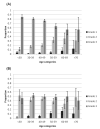Pathology of breast and ovarian cancers among BRCA1 and BRCA2 mutation carriers: results from the Consortium of Investigators of Modifiers of BRCA1/2 (CIMBA)
- PMID: 22144499
- PMCID: PMC3272407
- DOI: 10.1158/1055-9965.EPI-11-0775
Pathology of breast and ovarian cancers among BRCA1 and BRCA2 mutation carriers: results from the Consortium of Investigators of Modifiers of BRCA1/2 (CIMBA)
Abstract
Background: Previously, small studies have found that BRCA1 and BRCA2 breast tumors differ in their pathology. Analysis of larger datasets of mutation carriers should allow further tumor characterization.
Methods: We used data from 4,325 BRCA1 and 2,568 BRCA2 mutation carriers to analyze the pathology of invasive breast, ovarian, and contralateral breast cancers.
Results: There was strong evidence that the proportion of estrogen receptor (ER)-negative breast tumors decreased with age at diagnosis among BRCA1 (P-trend = 1.2 × 10(-5)), but increased with age at diagnosis among BRCA2, carriers (P-trend = 6.8 × 10(-6)). The proportion of triple-negative tumors decreased with age at diagnosis in BRCA1 carriers but increased with age at diagnosis of BRCA2 carriers. In both BRCA1 and BRCA2 carriers, ER-negative tumors were of higher histologic grade than ER-positive tumors (grade 3 vs. grade 1; P = 1.2 × 10(-13) for BRCA1 and P = 0.001 for BRCA2). ER and progesterone receptor (PR) expression were independently associated with mutation carrier status [ER-positive odds ratio (OR) for BRCA2 = 9.4, 95% CI: 7.0-12.6 and PR-positive OR = 1.7, 95% CI: 1.3-2.3, under joint analysis]. Lobular tumors were more likely to be BRCA2-related (OR for BRCA2 = 3.3, 95% CI: 2.4-4.4; P = 4.4 × 10(-14)), and medullary tumors BRCA1-related (OR for BRCA2 = 0.25, 95% CI: 0.18-0.35; P = 2.3 × 10(-15)). ER-status of the first breast cancer was predictive of ER-status of asynchronous contralateral breast cancer (P = 0.0004 for BRCA1; P = 0.002 for BRCA2). There were no significant differences in ovarian cancer morphology between BRCA1 and BRCA2 carriers (serous: 67%; mucinous: 1%; endometrioid: 12%; clear-cell: 2%). CONCLUSIONS/IMPACT: Pathologic characteristics of BRCA1 and BRCA2 tumors may be useful for improving risk-prediction algorithms and informing clinical strategies for screening and prophylaxis.
Figures



References
-
- Armes JE, Egan AJ, Southey MC, Dite GS, McCredie MR, Giles GG, et al. The histologic phenotypes of breast carcinoma occurring before age 40 years in women with and without BRCA1 or BRCA2 germline mutations: a population-based study. Cancer. 1998;83:2335–45. - PubMed
-
- Lakhani SR, Jacquemier J, Sloane JP, Gusterson BA, Anderson TJ, Van De Vijver MJ, et al. Multifactorial analysis of differences between sporadic breast cancers and cancers involving BRCA1 and BRCA2 mutations. J Natl Cancer Inst. 1998;90:1138–45. - PubMed
-
- Eisinger F, Jacquemier J, Charpin C, Stoppa-Lyonnet D, Bressac-de PB, Peyrat JP, et al. Mutations at BRCA1: the medullary breast carcinoma revisited. Cancer Res. 1998;58:1588–92. - PubMed
-
- Iau PT, Marafie M, Ali A, Sng JH, Macmillan RD, Pinder S, et al. Are medullary breast cancers an indication for BRCA1 mutation screening? A mutation analysis of 42 cases of medullary breast cancer. Breast Cancer Res Treat. 2004;85:81–8. - PubMed
Publication types
MeSH terms
Grants and funding
- U01 CA069417/CA/NCI NIH HHS/United States
- U01 CA69417/CA/NCI NIH HHS/United States
- 11174/CRUK_/Cancer Research UK/United Kingdom
- P30 CA51008-12/CA/NCI NIH HHS/United States
- A11174/CRUK_/Cancer Research UK/United Kingdom
- U01 CA116167/CA/NCI NIH HHS/United States
- CA116167/CA/NCI NIH HHS/United States
- 15007/CRUK_/Cancer Research UK/United Kingdom
- R01 CA122340/CA/NCI NIH HHS/United States
- C1287/A11990/CRUK_/Cancer Research UK/United Kingdom
- U01 CA069446/CA/NCI NIH HHS/United States
- U01 CA069638/CA/NCI NIH HHS/United States
- CA116201/CA/NCI NIH HHS/United States
- R01 CA140323/CA/NCI NIH HHS/United States
- CA128978/CA/NCI NIH HHS/United States
- C5047/A8385/CRUK_/Cancer Research UK/United Kingdom
- U01 CA069467/CA/NCI NIH HHS/United States
- RFA-CA-06-503/CA/NCI NIH HHS/United States
- 11022/CRUK_/Cancer Research UK/United Kingdom
- CAPMC/ CIHR/Canada
- C12292/A11174/CRUK_/Cancer Research UK/United Kingdom
- U01 CA069398/CA/NCI NIH HHS/United States
- CA74415/CA/NCI NIH HHS/United States
- N02PC45022-46/PC/NCI NIH HHS/United States
- R01 CA128978/CA/NCI NIH HHS/United States
- N02 CP011019/CP/NCI NIH HHS/United States
- N02 CP065504/CP/NCI NIH HHS/United States
- P30 CA051008/CA/NCI NIH HHS/United States
- R01 CA106588/CA/NCI NIH HHS/United States
- P50 CA058207/CA/NCI NIH HHS/United States
- R01 CA116167/CA/NCI NIH HHS/United States
- P50 CA116201/CA/NCI NIH HHS/United States
- MRC_/Medical Research Council/United Kingdom
- U01 CA113916/CA/NCI NIH HHS/United States
- U01 CA069631/CA/NCI NIH HHS/United States
- P50-CA058207/CA/NCI NIH HHS/United States
- RFA CA- 06-503/CA/NCI NIH HHS/United States
- U01 CA69398/CA/NCI NIH HHS/United States
- ImNIH/Intramural NIH HHS/United States
- 5U01CA113916/CA/NCI NIH HHS/United States
- U01 CA69638/CA/NCI NIH HHS/United States
- U01 CA69446/CA/NCI NIH HHS/United States
- U01 CA69631/CA/NCI NIH HHS/United States
- U01CA69631/CA/NCI NIH HHS/United States
- R01 CA074415/CA/NCI NIH HHS/United States
- 10118/CRUK_/Cancer Research UK/United Kingdom
- C1287/A10118/CRUK_/Cancer Research UK/United Kingdom
- U01 CA69467/CA/NCI NIH HHS/United States
LinkOut - more resources
Full Text Sources
Other Literature Sources
Medical
Molecular Biology Databases
Research Materials
Miscellaneous

